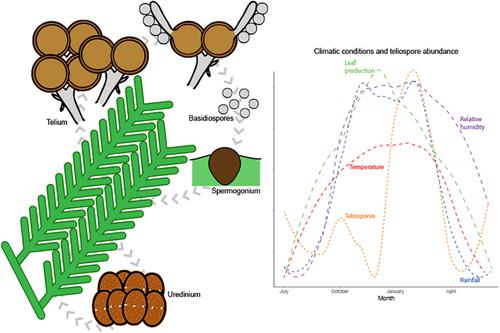当前位置:
X-MOL 学术
›
Ann. Appl. Biol.
›
论文详情
Our official English website, www.x-mol.net, welcomes your
feedback! (Note: you will need to create a separate account there.)
The life cycle and field epidemiology of Uromycladium acaciae (Pucciniales) on Acacia mearnsii in South Africa
Annals of Applied Biology ( IF 2.2 ) Pub Date : 2021-01-22 , DOI: 10.1111/aab.12677 Stuart Fraser 1, 2 , Alistair R. McTaggart 1, 3 , Jolanda Roux 1 , Johan Nel 4 , James Potgieter 4 , Louise Shuey 1, 5 , Chanatda Somchit 2 , Mike J. Wingfield 1
Annals of Applied Biology ( IF 2.2 ) Pub Date : 2021-01-22 , DOI: 10.1111/aab.12677 Stuart Fraser 1, 2 , Alistair R. McTaggart 1, 3 , Jolanda Roux 1 , Johan Nel 4 , James Potgieter 4 , Louise Shuey 1, 5 , Chanatda Somchit 2 , Mike J. Wingfield 1
Affiliation

|
Uromycladium acaciae has damaged plantations of Acacia mearnsii in southern Africa since 2013. Uredinia of a species of Uromycladium have been known on A. mearnsii in South Africa since the 1980s. However, the recent damage is associated with telia and spermogonia. Uredinia and telia were previously treated as conspecific with a phylogenetic species concept. However, uredinia did not form after previous artificial inoculation experiments with teliospores. Controlled studies identified the optimum conditions for basidiospore infection, but the optimum conditions for sporulation and dispersal have not been identified. To investigate the life cycle and field epidemiology of Uromycladium on A. mearnsii, spores were trapped weekly and development of disease symptoms and plant phenology were monitored monthly at three plantations. Telia and spermogonia developed independently from uredinia, and nucleotide polymorphisms between rDNA of uredinia and telia were fixed based on high throughput sequencing and PCRs. All three weather variables measured had a significant effect on teliospore abundance at two of the three sites. Teliospore abundance was greatest during trapping periods when mean relative humidity was high, mean rainfall was 4–5 mm day−1 and mean temperature was 15–16°C. Teliospore counts peaked at the end of summer, potentially the result of epidemic build-up. Results support the hypothesis that despite sharing a most recent common ancestor, uredinia on A. mearnsii in southern Africa are independent to the life cycle of the telial rust, which likely constitutes a new introduction. Furthermore, teliospores of U. acaciae disperse under wet conditions, and the wet season between October and March is the optimal period for wattle rust development.
中文翻译:

南非金合欢上金合欢(Pucciniales)的生命周期和现场流行病学
自 2013 年以来,Uromycladium acaciae已经破坏了南部非洲的Acacia mearnsii种植园。自 1980 年代以来,在南非的A. mearnsii上就发现了一种Uromycladium 的 Uredinia。然而,最近的损害与特利亚和精原细胞有关。Uredinia 和 telia 以前被视为具有系统发育物种概念的同种。然而,在之前用冬孢子进行人工接种实验后,乌尔丁尼亚没有形成。对照研究确定了担子孢子感染的最佳条件,但尚未确定孢子形成和传播的最佳条件。为了研究的生命周期和现场流行病学Uromycladium上A.荆,孢子每周被捕获,并且在三个种植园每月监测疾病症状和植物物候的发展。Telia 和精原细胞独立于 urdinia 发育,通过高通量测序和 PCRs 确定了 urdinia 和 telia rDNA 之间的核苷酸多态性。测量的所有三个天气变量对三个地点中两个地点的冬孢子丰度都有显着影响。冬孢子丰度在平均相对湿度高、平均降雨量为 4-5 毫米-1天且平均温度为 15-16°C 的诱捕期间最大。冬孢子数在夏末达到顶峰,这可能是流行病积累的结果。结果支持这样的假设,即尽管共享最近的共同祖先,A. mearnsii上的urdinia在南部非洲的 telial rust 的生命周期是独立的,这可能构成一个新的引入。此外,刺槐冬孢子在潮湿条件下分散,十月至三月的雨季是荆棘锈病发展的最佳时期。
更新日期:2021-01-22
中文翻译:

南非金合欢上金合欢(Pucciniales)的生命周期和现场流行病学
自 2013 年以来,Uromycladium acaciae已经破坏了南部非洲的Acacia mearnsii种植园。自 1980 年代以来,在南非的A. mearnsii上就发现了一种Uromycladium 的 Uredinia。然而,最近的损害与特利亚和精原细胞有关。Uredinia 和 telia 以前被视为具有系统发育物种概念的同种。然而,在之前用冬孢子进行人工接种实验后,乌尔丁尼亚没有形成。对照研究确定了担子孢子感染的最佳条件,但尚未确定孢子形成和传播的最佳条件。为了研究的生命周期和现场流行病学Uromycladium上A.荆,孢子每周被捕获,并且在三个种植园每月监测疾病症状和植物物候的发展。Telia 和精原细胞独立于 urdinia 发育,通过高通量测序和 PCRs 确定了 urdinia 和 telia rDNA 之间的核苷酸多态性。测量的所有三个天气变量对三个地点中两个地点的冬孢子丰度都有显着影响。冬孢子丰度在平均相对湿度高、平均降雨量为 4-5 毫米-1天且平均温度为 15-16°C 的诱捕期间最大。冬孢子数在夏末达到顶峰,这可能是流行病积累的结果。结果支持这样的假设,即尽管共享最近的共同祖先,A. mearnsii上的urdinia在南部非洲的 telial rust 的生命周期是独立的,这可能构成一个新的引入。此外,刺槐冬孢子在潮湿条件下分散,十月至三月的雨季是荆棘锈病发展的最佳时期。











































 京公网安备 11010802027423号
京公网安备 11010802027423号